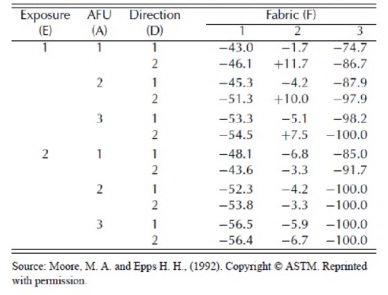Weathering experiment:
An experiment is described in the paper "Accelerated weathering of marine fabrics" (Moore, M. A. and Epps, II. IL. Journal of Testing and Evaluation 20, 1992, 139-143). The purpose of the experiment was to compare the effects of different types of weathering on the breaking strength of marine fabrics used for sails. The factors of interest were
F: Fabric at 3 levels (1 = polyester. 2 = acrylic, 3 = nylon).
E: Exposure conditions (1 = continuous light at 62.7°C, 2 = alternating 30 minutes light and 15 minutes condensation).
A: Exposure levels (1 = 1200 AFTJ, 2 = 2400 AEU, 3 = 3600 Aru).
D: Direction of cut of the fabric (1 = warp direction, 2 = filling direction).
In total there were v = 3x2x3x2 = 36 treatment combinations, and r — 2 observations were taken on each. 1 he response variable was "percent change in breaking strength of fabric after exposure to weathering conditions." The average response for each of the 36 treatment combinations is shown in Table. The error mean square was calculated to be 6.598 with 36 degrees of freedom.
Table: Percent change in breaking strength of fabrics after exposure

(a) How would you decide whether or not the error variables have approximately the same variance for each fabric?
(b) Using the cell-means model, test the hypothesis Ho: [τ1 = .... = τ36 against the alternative hypothesis HA : fat least two τi's differ]. What can you conclude?
(c) Write down a contrast in the treatment combinations that compares the polyester fabric with the nylon fabric. Is your contrast estimable?
(d) If your contrast. in (c) is estimable, give a formula for the least squares estimator and its variance. Otherwise, go to part (e).
(e) Assuming that you are likely to be interested in a very large number of contrasts and you want your overall confidence level to be 95%, calculate a confidence interval for any pairwise comparison of your choosing. What does the interval tell you?
(f) Calculate a 90% confidence bound for a2.
(g) If you were to repeat this experiment and you wanted your confidence interval in (d) to be of length at most 20%, how many observations would you take on each treatment combination?